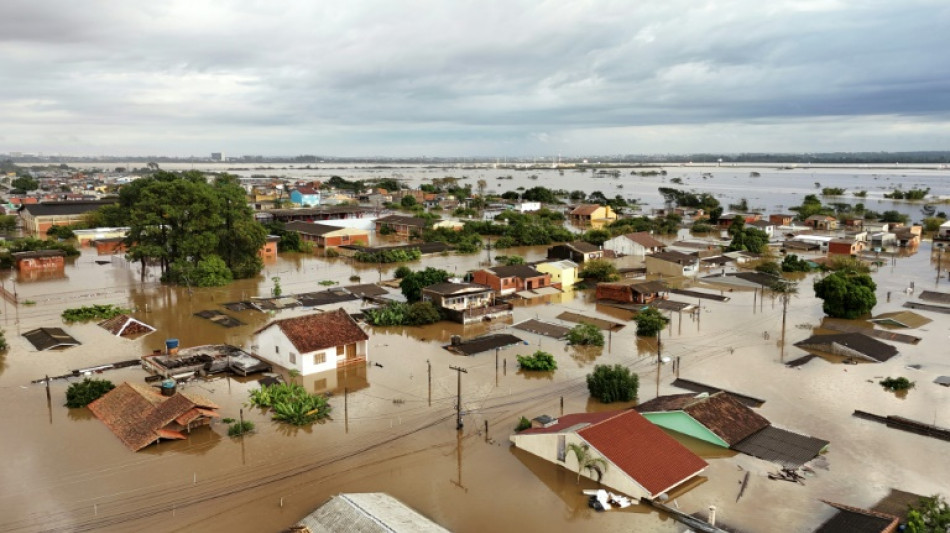
Brazil mounts frantic rescue effort as flooding kills 75

Authorities in southern Brazil scrambled Sunday to rescue people from raging floods and mudslides that have killed at least 75 and forced more than 88,000 to flee their homes.
All over Porto Alegre, the capital of Rio Grande do Sul state, people stood on rooftops hoping to be rescued as others in canoes or small boats navigated streets that have become rivers.
Viewed from the air, Porto Alegre was completely flooded, with streets under water and the roofs of some houses barely visible.
Civil defense officials said at least 103 people were missing in the latest of a string of catastrophic weather events to hit the South American giant.
More than 3,000 soldiers, firefighters and other crews worked frantically to save people stranded by the floods over the past few days, in many cases without basics like running water or electricity.
"It looks like a scene out of a war, and after it is over it will require a post-war approach," Rio Grande do Sul governor Eduardo Leite said, flanked by President Luiz Inacio Lula da Silva and several government ministers.
Lula promised the government would provide all necessary resources for reconstruction.
Besides Porto Alegre, another 334 towns and villages have been hit by the flooding, caused by torrential rain.
Soldiers are setting up field hospitals after hundreds of patients had to be evacuated from regular hospitals.
Seventy percent of Porto Alegre is without running water and much of the metropolitan area is under water, officials said.
The Guaiba River, which flows through the city of 1.4 million people, reached a record high level of 5.3 meters (17.4 feet), according to the local municipality, well above the historic peak of 4.76 meters that had stood as a record since devastating 1941 floods.
Rosana Custodio, a 37-year-old nurse, fled her flooded Porto Alegre home with her husband and three children.
"During the night on Thursday the waters began to rise very quickly," she told AFP via a WhatsApp message.
"In a hurry, we went out to look for a safer place. But we couldn't walk... My husband put our two little ones in a kayak and rowed with a bamboo. My son and I swam to the end of the street," she said.
Her family was safe but "we've lost everything we had."
- 'It's terrifying' -
Authorities scrambled to evacuate swamped neighborhoods as rescue workers used four-wheel-drive vehicles -- and even jet skis -- to maneuver through waist-deep water in search of the stranded.
Governor Leite said his state, normally one of Brazil's most prosperous, would need a Marshall Plan of heavy investment to rebuild.
Sunday will be a key day for the rescue effort, said Paulo Pimenta, a senior communications official under Lula.
Long lines formed as people tried to board buses in many places, although bus services to and from the city center were canceled.
The Porto Alegre international airport suspended all flights on Friday for an undetermined period. Its runways are under water.
Lula posted a video of a helicopter depositing a soldier atop a house, who then used a brick to pound a hole in the roof and rescue a baby wrapped in a blanket.
The speed of the rising waters unnerved many.
"It's terrifying because we saw the water rise in an absurd way, it rose at a very high speed," said Greta Bittencourt, a 32-year-old professional poker player.
- 'Disastrous cocktail' -
Leite said this was the worst natural disaster in the history of Rio Grande do Sul, which is home to agroindustrial production of soy, rice, wheat and corn.
Rescuers faced a colossal task, with entire towns inaccessible.
Lula, who visited the state twice in a matter of days, has blamed the disaster on climate change.
The devastating storms were the result of a "disastrous cocktail" of global warming and the El Nino weather phenomenon, climatologist Francisco Eliseu Aquino told AFP on Friday.
South America's largest country has recently experienced a string of extreme weather events, including a cyclone in September that killed at least 31 people.
(V.Sørensen--DTZ)
